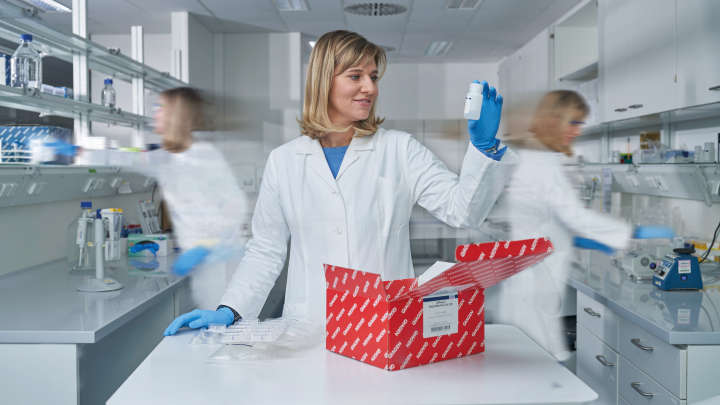✓ 全天候自动处理在线订单
✓ 博学专业的产品和技术支持
✓ 快速可靠的(再)订购
QIAcuity Nanoplate 26k 8-well (10)
目录编号 / ID. 250031
✓ 全天候自动处理在线订单
✓ 博学专业的产品和技术支持
✓ 快速可靠的(再)订购
特点
- 四款针对不同应用需求的纳米微孔板
- 每孔多达 8500 个或 26,000 个反应分区
- SBS 格式
产品详情
QIAcuity Nanoplate 是微流体数字 PCR 孔板,可让您以每孔最多 8500 个或 26,000 个反应分区运行 8 份、24 份或 96 份样本。所有四款纳米微孔板均旨在 QIAcuity 数字 PCR 仪器上运行。
这些纳米微孔板仅供与 QIAcuity Digital PCR System一起使用。使用 QIAgility 在 QIAcuity Nanoplate 中进行自动化液体处理和 PCR 反应体系构建时应使用专用的 QIAcuity Nanoplate 适配器。操作完成后,将该孔板加载到 QIAcuity Digital PCR System 上进行 dPCR 反应。
您想要进一步了解该产品并让我们的 dPCR 专家联系您吗?请在这里登记,我们将很快与您联系。
绩效
这些孔板经过专门设计,专供用于在 QIAcuity 仪器中进行数字 PCR 反应。QIAGEN 提供的纳米微孔板有四种类型,均为边合成边测序 (Sequencing by Synthesis, SBS) 格式,但规格有所不同,可满足不同的应用需求。
| 类型 | 框架颜色 | 规格 | 应用 |
| Nanoplate 26K 8-well | 浅蓝色 |
8 孔 x 大约 26,000 个反应分区 每孔 40 µL dPCR 反应体系 |
罕见突变检测、 液体活检、基因 表达分析、 病原体检测等。 |
| Nanoplate 26K 24-well | 蓝色 |
24 孔 x 大约 26,000 个反应分区 每孔 40 µL dPCR 反应体系 |
罕见突变检测、 液体活检、基因 表达分析、 病原体检测等。 |
| Nanoplate 8.5K 24-well | 白色 |
24 孔 x 大约 85,000 个反应分区 每孔 12 µL dPCR 反应体系 |
拷贝数变异 分析、基因表达 分析、NGS 文库 定量、基因编辑 检测等。 |
| Nanoplate 8.5K 96-well | 灰色 |
96 孔 x 大约 85,000 个反应分区 每孔 12 µL dPCR 反应体系 |
原理
仅需 3 个简单的步骤——移液及加载、运行实验和分析结果,您就能在 2 小时内获得 dPCR 结果。有关纳米微孔板中 dPCR 反应的原理说明,请参见这里。
程序
与 qPCR 实验一样,样本制备包括将预混液、探针和引物转移到一个 8 孔、24 孔或 96 孔纳米微孔板中,随后添加样本该系统将微分化、热循环和成像集成到单一全自动化的仪器上,使用户可在 2 小时内获得结果。您可在 Suite Software 上执行分析,该软件可针对您的靶序列及质量控制(例如阳性样本或无模板对照 [NTC])给出以每微升拷贝数表示的浓度。该分析还可在同一局域网 (LAN) 上的远程计算机上执行。
应用
QIAcity 纳米微孔板与 QlAcuity Digital PCR System 和 QIAcity PCR 试剂盒的联合使用可让您执行各种数字 PCR 应用,包括:
- 罕见突变检测
- 拷贝数变异分析
- 基因表达分析
- 病原体检测
- 基因分型
- miRNA 研究
- 细胞和基因治疗
- 残留 DNA 定量
- 废水监测

